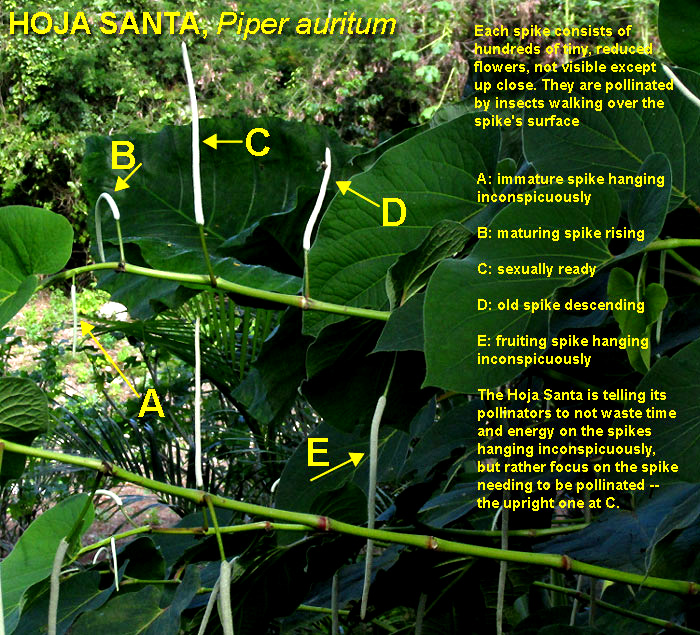
An Excerpt from Jim Conrad's
NATURALIST NEWSLETTER
January
10, 2016
issued
from Hacienda Chichen Resort adjoining Chichén Itzá Ruins in YUCATÁN, MÉXICO
Each afternoon, every day of the week, at 4PM I climb the Hacienda veranda's steps to see if anyone wants to accompany me on a free walk around the grounds, looking at things. Normally we end the walk when it gets too dark to see more.
That day the only person waiting was Eric, a French speaker from Switzerland, an old fellow with wispy, white hair, wearing sunglasses on the shady veranda, and especially well dressed, almost formally. Everything about him was crisp and subdued, and I wasn't sure how this walk would go.
However, when I began describing how beautifully adapted the Royal Palms along our entrance road are for the Yucatan's long dry seasons, he actually stood looking at the trees smiling as if he really understood that the adaptations were as gorgeous as the trees' appearance.
By the time we got to the Strangler Fig's life cycle he was shifting his weight from foot to foot, surveying the big Strangler from side to side and asking me to clarify certain points he feared his English wasn't good enough to get straight. Looking up and down the old tree, he was clearly visualizing how the many separate stem-roots had merged to form the big trunk before us now, and he seemed amazed, as he should have been.
As the walk progressed, some kind of excitement or tension seemed to be building in the old man, but I thought maybe he was annoyed with mosquitoes and was too polite to say he wanted to abandon the walk.
Finally as it was getting dark and bats swarmed from the cavity atop the big Piich tree in the Organic Garden, and I was explaining how the Hoja Santa tree signaled to its pollinators which flowers it should visit, I finally understood what was going on with Eric. For, exactly as I finished showing what the Hoja Santa was doing, he burst into a laugh so uninhibited that it caused the parrots to stop squawking for a few seconds: During our walk, what seemed to me to be his restlessness was just his delight in learning new things.
It was a loud laugh, one like a child makes when being tickled.
That night, sitting in the hut thinking about it, I decided that Eric's laugh had been as beautiful as anything we'd seen that day.
For, as far as laughing goes, you have to figure that humans have evolved laughing as a signal to others indicating that one finds it agreeable to be in other people's presence, so laughing promotes social solidarity, which is advantageous -- adaptive -- to the social unit.
But, Eric's laugh had been building up pressure all during the walk, and when it erupted there had been no one around but me, who after the walk he'd never see again. His laugh had exploded in a social vacuum where nothing was funny, but there was indeed the glorious fact that the Hoja Santa communicated with its pollinators.
It's interesting to distinguish between these two kinds of laughter because laughter in a social context is just something that happens because humans are predisposed to do it. It may be agreeable and adaptive and have its own aesthetic value, but it's just like everything else in the Universe that for the most part is set on auto-pilot.
However, because one current of the Impulse that created the Universe and keeps it going tends toward ever-greater insight and feeling -- as described on our Six Miracles Page at http://www.backyardnature.net/j/6/ -- Joy in learning utterly harmonizes with the Universe's evolutionary flow. Here on Earth, when joy-in-learning flickers into existence someplace, it must create such a transcendent resonance with the Universal Flow that it can be expressed in no way other than with a gleeful laugh.
In fact, sometimes I think that the whole Universe is a laugh. It's a laugh of the Universal Creative Spirit Herself who, a moment before the Big Bang and in Her own social vacuum, was feeling more and more unsettled by some kind of urge, some kind of tickling, so at last all She could do was to burst out laughing, and the Universe was born.
And today that laughter keeps ricocheting and echoing across time and space, even to our obscurely positioned galaxy and our mediocre but adequate sun, and our wonderful little Earth, in a tiny corner of which stands a big Piich tree with bats flying out of it at dusk, where an Hoja Santa signals so expressively to its pollinators.
Below, you can see how the Hoja Santa signals to its pollinators:
